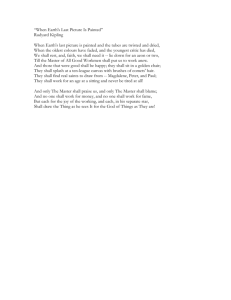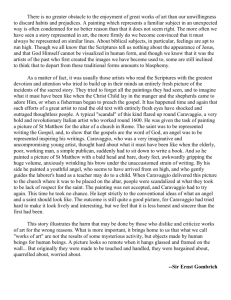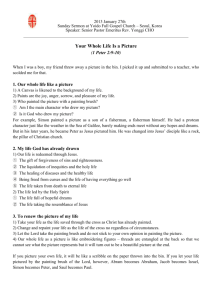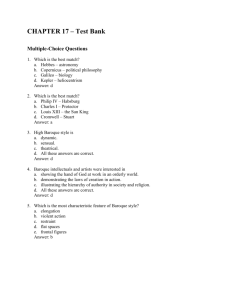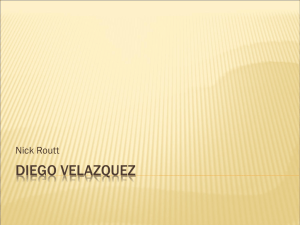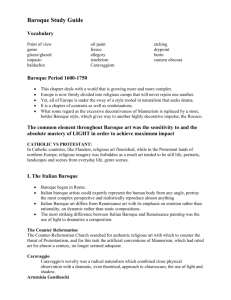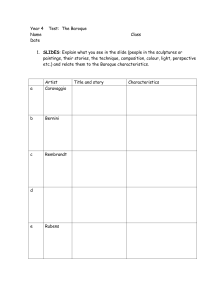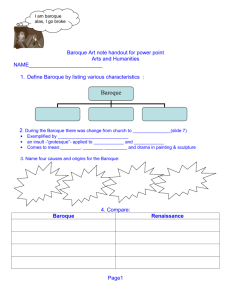PowerPoint Presentation - Fort Thomas Independent Schools
advertisement
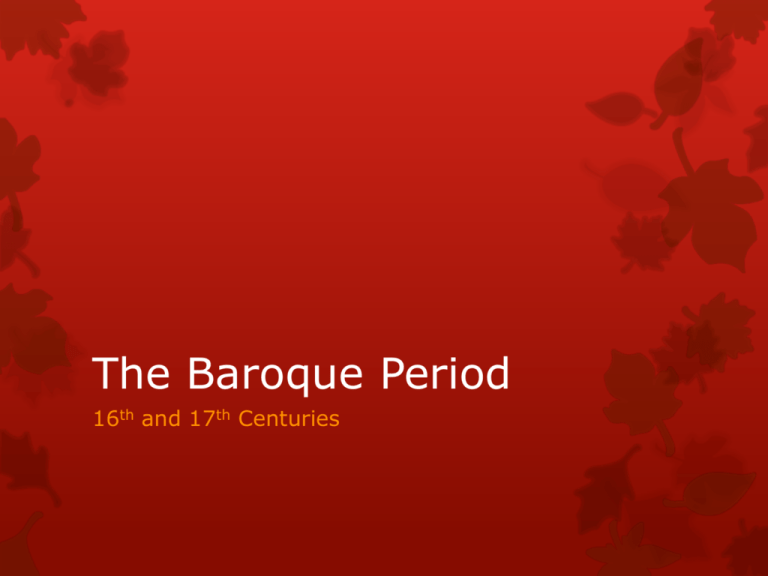
The Baroque Period 16th and 17th Centuries What’s going on in the world Religious Conflict continues The Reformation was aimed at “reforming” the corruption of the Catholic Church It spread throughout Europe but did not eradicate Catholicism completely Catholics instituted some reforms of its own but also sought to suppress its dissenters, like the Protestants. This led to what was known as the “CounterReformation” Let’s Look at England Henry VIII- began England’s Reformation because of his desire to annul his marriage to Catherine of Aragon Edward VI (ruled from 1547-1553) sympathized with the Protestant movement and took it further than Henry had. Mary (ruled from 1553-1558) was raised in France and a devote Catholic. Reversed what Edward had done and turned the country back to Catholicism Elizabeth I (ruled from 1558-1603) Was aware of the damage of warring religious doctrine and created a compromise between Catholicism and Protestantism. James I (ruled from 1603-1625) A Protestant that felt he answered directly to God. He did not understand or respect Parliament’s role in the government. Charles I (ruled from 1625-1642) Also a Protestant – like his father he did not respect Parliament which at this point had become mostly Puritan. In 1642 rebellion broke out led by Puritan Leader Oliver Cromwell. The Puritans defeated the Royal Forces and Charles I was beheaded. Ups and Downs of England Puritans remained in control until 1660 In 1660 Charles II was restored to power and he returned a balance to the English Monarchy. This is referred to as the Restoration. Puritan control led to heavy rules and restrictions on the citizens of England. This included the mandated closure of ALL public theatres. Elsewhere The Thirty Years war (1618-1648) was a German Catholic Campaign to suppress the Protestant faith in their country. King Louis XIV of France revoked the Protestants right to worship in 1685, and expelled Protestants from France Developments in Science Mathematics used to explain a variety of how things worked in nature. Copernicus theorized that the Sun, and not the Earth, was the center of our Universe. Galileo invented the telescope- study of the “heavens” was no longer done with just the naked eye. Galileo also formulated ideas of motion and how different masses affected each other. Francis Bacon called for a new approach to studying nature, and developed the Empirical method which relies on observation and experience as the roads to truth. Rene Descartes questioned the role and power of man and coined the phrase “I think, therefore I am” Isaac Newton- Laws of Motion, Theory of Gravity William Harvey- the circulation of blood Anton Van Leewenhoek- developed the microscope Developments in Philospohy Thomas Hobbes – philosophy based in the Scientific Revolution. Man is “moved” by two basic emotions: Desire and Aversion. John Locke- Believed that the mind was a blank slate and all knowledge comes from sense perception. People were products of their environment. Locke tried to establish laws of human nature by inductive means as opposed to the deductive methods of many scientists. The Term Baroque Originally meant a logical process that was contorted or twisted. In Portuguese “perola barroca” was a term used by jewelers to designate a rough or irregularly shaped pearl. The French by the 18th Century used the term to mean “a painting in which the rules of proportion are not observed and everything is represented according to the artist’s whim” All of these meanings were originally pejorative or derogatory. The Term Baroque continued As the 17th century was revalued “baroque” came to mean the opposite of “classical” (meaning works of antiquity or the High Renaissance) In this sense the term suggested art that was naturalistic rather than ideal and emotional rather than rational. Focused on movement, vitality and brilliant color Subjects could be chosen from a wide spectrum including daily life. Artists of the Baroque Period Caravaggio (1573-1610) Artemisia Gentileschi (1593-1652/3) Peter Paul Rubens (1577-1640) Rembrant (1606-1669) Jan Vermeer (1632-1675) Diego Rodriquez de Silva y Valaquez (1599-1660) Caravaggio Came to Rome in his late teens Lived like a rebel, was very violent which caused him to be accused of Murder “His anger suffused (or filled) his artistic style” His work was considered highly dramatic and sometimes shocking Was known for his stark contrasting of light and darkness with little intermediate value The Conversion of St. Paul Painted by Caravaggio c. 1601 St. Paul viciously persecuted the followers of Jesus (after his death) until while on his way to Damascus Jesus appeared to him and asked him why he was persecuting his followers. Paul was so moved he became a follower of Jesus himself. Caravaggio chooses to depict the moment that Paul, blinded by the light of Jesus, has fallen off his horse. The Calling of St. Matthew Painted by Caravaggio c. 1598 Depicts a moment in Jesus’s life when he first encountered St. Matthew. Seeing him in a tax collector’s office Jesus said “Follow me” and Matthew got up and follow him. Again Caravaggio chooses to depict the moment with the most tension. Atemisia Gentileschi One of many women artists who emerged when master painters began to recognize that women might be as talented as men. Trained by her artist father. Was influenced by Caravaggio, but as she matured she developed her own style. Among her favorite subjects was the biblical heroine Judith. Judith and Maidservant with the Head of Holofernes Painted by Gentileschi c. 1625 Judith enters the tent of Holofernes, her people’s would be conqueror, while he is in a drunken stupor and beheads him saving her people. Again we see the dramatic use of light, tension is created by some unseen moment. Is someone entering the tent? Did they hear a sound? But they seem strangely calm for having just cut off someone’s head. Peter Paul Rubens Raised as a Protestant and fled the Netherlands after it came under the control of Catholics, converted to Catholicism after his father’s death when his family returned to Antwerp. Studied the works of Michelangelo, Da Vinci, Raphael and Caravaggio. From these sources he created his own distinctive, optimistic and visually rich view of the world. The Raising of the Cross Painted by Peter Paul Rubens, center of a triptych (a three part altarpiece) 1609-1610 Pretty self explanatory … Can you see the influence of Da Vinci and Michelangelo in regards to Christ’s physique? Caravaggio’s influence in the use of light? Arrival of Marie de Medici at Marseilles Painted by Rubens as 1 in a series of 22 works commissioned by Medici in 1621-22 Linked myth, fact, history and allegory to celebrate the real life Marie. She is greeted by France, attended by Fame and Neptune whose court rises out of the water boat side. What does this say about Marie de Medici? Do we see the influences we mentioned earlier in this work as well? Garden of Love Painted by Ruebens in 1638 Influenced by his second marriage An example of his work that did not feature religious figures or members of nobility. Where can we see the influences in this piece? Rembrandt Grew up in Protestant Holland The churches were not great patrons of the arts, but the country was filled with a growing class of prosperous Calvinists and Lutherans who wanted and acquired art to adorn their homes. For the first time artists were making their living in the free market. Rembrandt was moved by the “internal” life with all the emotions that went with it. He painted many self portraits that explore the changes life leaves on the body and soul. What changes do you see? Are they deeper than just the change in age? The Syndics of the Drapers Painted by Rembrandt in 1662 Syndics means representative or delegate Do you feel engaged in this painting? Why? What is happening? What were these man talking about? Jan Vermeer Dutch painter Specialized in domestic interior scenes of middle class life Works frequently feature subject situated next to a window. Woman Holding a Balance Painted by Vermeer Domestic situation- no “story” to reveal The Kitchenmaid Painted by Vermeer c. 1658 Similar composition- subject close to a window Girl with a Pearl Earring Painted by Vermeer, but not dated Was not meant to be a full portrait, but more likely a study of the face. This painting is often called “The Mona Lisa of the North” or “The Dutch Mona Lisa” Diego Rodriquez de Silva y Velasquez Court painter of Philip IV in Spain Was most well known for his portraits Painted 40 portraits of Philip as well as various members of his court. Las Meninas (The Ladies-inWaiting) Painted by Velazquez in 1656 Considered to be his masterpiece A lot things visible in this image 5 year old princess at the paintings center Velazquez himself to the left, in the midst of painting Ladies-in-waiting attend the princess, including two dwarves on the right A court official enters a lighted doorway in the back The king and queen are visible in the mirror at the back of the painting Baroque Visual Art The Baroque period stretched across Europe, and Artists influences were numerous- including location. Strongest Characteristics: Strong contrasts in use of light Emotional and Dramatic
